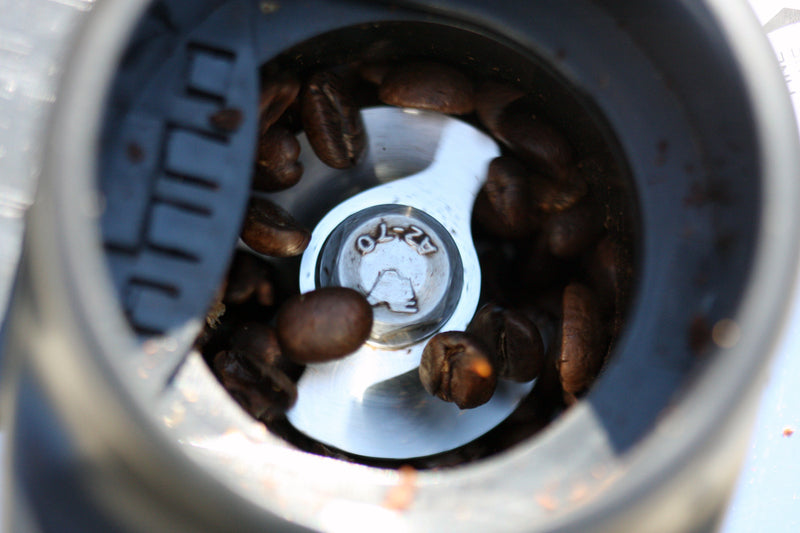It is a commonly held belief within the coffee community that grinder hoppers should be kept full of beans to reduce the ‘popcorn effect’. The popcorn effect refers to coffee beans bouncing around in the grinder hopper before they are engaged by the grinder burrs. Apparently, if the beans are allowed to jump for joy before being ground to pulp the espresso extraction will be different when compared to an extraction from beans weighed down in the hopper.
What could account for the perceived difference? On grinders with electronic timers, the dose may be smaller since the beans are not forced into the burrs at the same rate. On any grinder, the particle size distribution of the grinds may be different because the effective contact time between gnashing burrs and crunchy beans is different, leading to a higher or lower proportion of fine particles, for example.
In an attempt to bust the myth of popcorn I have conducted a couple of experiments.
First, let’s test whether the mass of beans above the burrs has any effect on the dose from an electronically timed grinder. Figure 1 shows how the dose varies with the mass of beans in the hopper of a Mazzer Kony Electronic grinder set to grind for a time of 6.0 seconds. The dotted lines show a range of two standard deviations (a statistical measure describing the spread in the data, 95% of the data should fall within two standard deviations) based upon the first ten doses, which are shown as hollow diamonds. These first ten doses have been ground with between approximately 800 and 600 grams of beans in the hopper — representing a full hopper. The masses of the next 25 doses, shown as solid diamonds, fall within the two standard deviation range and don’t show any trend towards a higher or lower dose. Only the last full dose, shown as a hollow circle, falls outside the range. The very last dose (not shown) was only 10.3 grams, but it’s not relevant because the grinder ran out of beans.
So it seems that evidence of the popcorn effect is only apparent for the single, last full dose in an electronically timed grinder. There is little or no popcorn effect observed as the bean mass in a hopper reduces.
And now to ground coffee particle size distributions. When coffee is ground in a burr grinder the particles are not all the same size. For typical espresso there is a distribution of sizes ranging from a few micrometres to a few hundred micrometres. The size distribution usually shows a high proportion of relatively large particles and also of fine particles with a lower number of particles finer, larger and in between these two predominant sizes, ie a bimodal distribution as shown in Figure 2. Unfortunately I do not have access to laser scattering, particle sizing equipment (as yet) but I do have a device which can measure the dissolved solids in brewed coffee. If the particle size distribution is different between ground coffee samples then it may be possible to measure this as a difference in the fraction of dissolved solids in brewed coffee.
Three samples of coffee were ground with a full hopper (~ 1kg beans) and a further three were ground with only 20g of beans at a time. Ten grams of each sample were then brewed in 100g of ~95°C water for three minutes. The brews were then each filtered through two Melitta filter papers and cooled to room temperature. An ExtractMojo refractometer was used to measure the total dissolved solids (TDS) in the brewed coffee. Five TDS measurements were made on each sample and combined statistically as shown in Figure 3. The error bars on each data point are one standard deviation in the five repeat measurements for each sample. They indicate the uncertainty in measuring the TDS for each sample. The dotted lines for each set of three samples indicate one standard deviation for all of the data and indicate an uncertainty on the combined result.
NEWSFLASH: ExtractMojo cannot see the popcorn effect! Since all of the uncertainty ranges overlap it is not possible to determine if there is any difference between brewed extractions when grinding with a full or empty hopper.
These two simple experiments have not conclusively demonstrated that there isn’t a popcorn effect. In fact, with an all but empty hopper, an electronically timed grinder will yield a lower dose. However, this is simply a lower dose and no barista would be surprised to see their extractions change if the dose is changed. The precision of the TDS measurements is not sufficient to observe differences that may exist in the brewed coffee data. If you have a laser scattering, particle counter handy, please let me know and we’ll continue with the experiment!
Author: Graeme Burton, Five Senses Coffee







